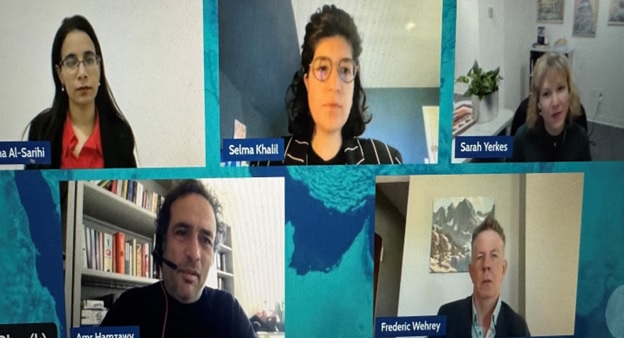

Top: (L) Aisha Al-Sarihi, (M) Selma Khalil, (R) Sarah Yerkes. Bottom: (L) Amr Hamzawy, (R) Frederic Wehrey
Engaging Youth Activists Benefits Climate Change Efforts in MENA Region
By Elaine Pasquini

Washington: Climate change is a growing concern worldwide with experts struggling to find solutions every day. Funding in this area is dire for many countries, especially since the American administration’s recent cuts to USAID, which had been one of the main contributors to climate change efforts in the Middle East-North Africa (MENA) region.
“So, now is the time for governments to get smart and draw from within from their own resources,” said Frederic Wehrey, senior fellow at the Middle East Program at the Carnegie Endowment for International Peace, in an April 9 webinar hosted by CEIP. “I think this massive shock we’re experiencing now just underscores that imperative.”
One country which should be applauded for implementing well-developed plans in setting carbon reduction goals and the transition to solar energy is Morocco, he said.
The country, however, is the second-most water scarce country in North Africa and with some 93 percent of its land being arid or semi-arid this impacts the agriculture sector, which comprises10 percent of the GDP, Wehrey explained. But 30 percent of the population depend on their livelihood from farming or are associated with the rural economy. About 70 percent of this agricultural output comes from small plot family-owned farms and oasis-dwellers.
Morocco’s deeply unequal system of water distribution which was inherited from the French colonial period has carried over into the monarchy where water is a source of political clientelism, benefiting rich landowners, he said. While measures have been taken over the years to correct this imbalance, the interests of the same “regime-connected elites” are perpetuated. “This is all political and has to do with the nature of the Moroccan monarchy system…and has led to sporadic protests.”
The local farmers have the expertise…traditional indigenous traditions for managing water. “The government just needs to listen,” Wehrey said.
And in Libya, municipal governments want to be “more than service providers in terms of climate action, they want to be empowered,” he said. “The problem is these grassroots individuals are facing outdated legislation…that doesn’t empower them.”
Sarah Yerkes, senior fellow at the Middle East Program at CEIP, pointed out the importance of youth activism in tackling climate challenges, noting that young people make up a large proportion of the population of the MENA region.
In her opinion, governments in North Africa are largely incapable of addressing rapidly increasing climate challenges on their own, so it would be in their best interests to strengthen civil society, including the large youth segment who are educated and have important tech skills.
Partnering with youth and empowering them to address climate adaptation and mitigation would assist governments in this challenge, but also “help bridge the trust gap” between young people and their governments, she added. “The one thing that governments can do is actually listen to them…and harness the skills of these young people.”
Several North African governments have been increasingly trying to give youth a seat at the table when it comes to policymaking, she explained. Particularly during sessions of the United Nations-directed Conference of the Parties (COP) that were held in Sharm el-Sheikh and Dubai, a growing number of young people from Egypt, Tunisia and Morocco had seats at the negotiating table.
Selma Khalil, an MBA candidate at Johns Hopkins University School of Advanced International Studies, said financing the green transition in Egypt would require a stable macroeconomic condition with transparency, along with stronger accountability mechanisms and a smoother regulatory process.
In addition, “leveraging the robust local talent can really add value to the supply chain when it comes to green projects or infrastructure,” she noted.
Egypt’s difficult economic conditions and declining foreign direct investment remittances are exacerbated by Israel’s war on neighboring Gaza. Despite these challenges, Egypt is looking at ambitious modernization projects.
With respect to Egypt’s underemployment labor problem, moderator, Amr Hamzawy, director of the Middle East Program at CEIP, who has family in upper Egypt, added that the central government in Cairo needs to pay attention to local voices and vulnerable groups with respect to hiring and providing employment.
Aisha Al-Sarihi, a non-resident fellow at the Middle East Council on Global Affairs and the Arab Gulf States Institute, noted that the Gulf countries have been slower than North Africa in their climate adaptation and mitigation efforts due to the oil and gas wealth which has limited civil society participation.
This industry contributes significantly to Gulf economies, and “the clean energy sector itself might not generate the same kind of revenue as the hydrocarbon sector,” she said, but it keeps power and desalination plants operating.
Because Gulf countries have an arid environment and the region is suffering from extreme heat, water scarcity and food insecurity, doing away with the traditional oil and gas industry would constitute an “existential threat” for the Gulf countries, she argued.
On a positive note, Al-Sarihi related that youth participation in climate action had recently increased along with that of small and middle-sized private businesses. Young people in Oman, for example, have traveled and studied abroad, returning with ideas to help with climate change issues.
(Elaine Pasquini is a freelance journalist. Her reports appear in the Washington Report on Middle East Affairs and Nuze.Ink.)

